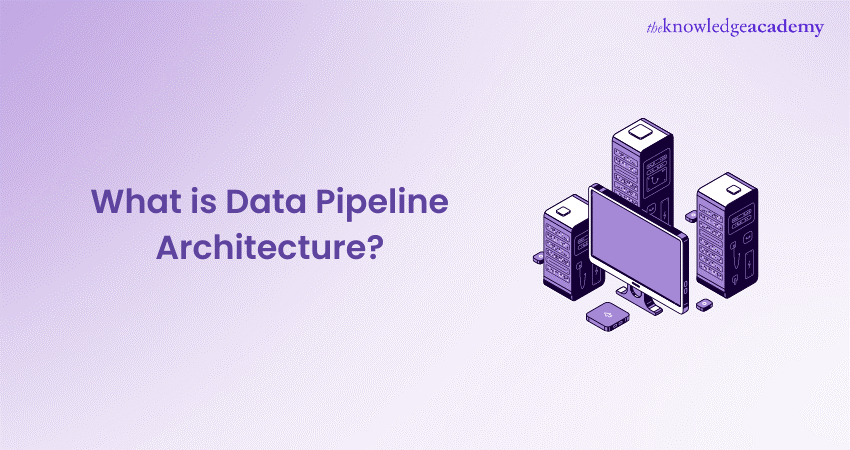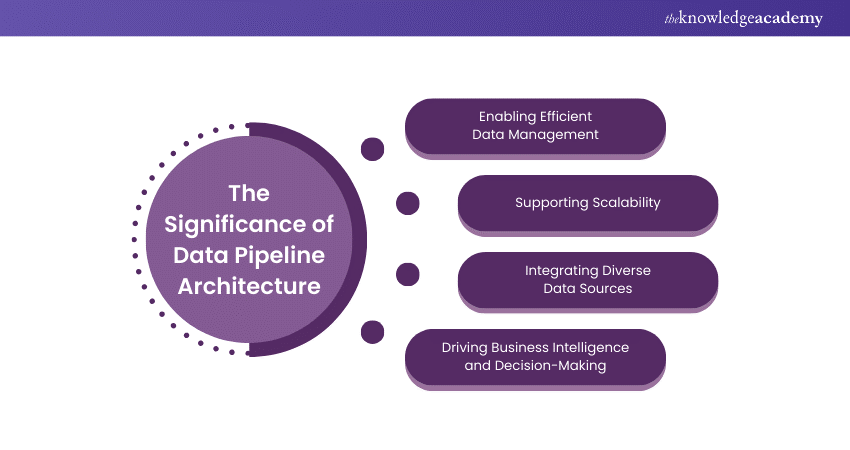We may not have the course you’re looking for. If you enquire or give us a call on +1 6474932992 and speak to our training experts, we may still be able to help with your training requirements.
Training Outcomes Within Your Budget!
We ensure quality, budget-alignment, and timely delivery by our expert instructors.

In this expeditious digital world, Data Pipeline Architecture plays a critical role. It is significant in the sphere of data analytics, supporting business intelligence (BI), data analysis, and decision-making processes. Its work extends beyond the mere act of moving data. It is the foundation of modern data analytics. Let's explore its significance in this blog, so read through to discover it all.
Table of Contents
1) Defining Data Pipeline Architecture
2) The significance of Data Pipeline Architecture
3) Common solutions for Data Pipelines
4) Selecting a design pattern
5) Technlogies and techniques for Data Pipelines
6) Conclusion
Defining Data Pipeline Architecture?
Data Pipeline Architecture refers to the conceptual design and framework used to collect, process, and move data from one or more sources to another destination. There, the data can be stored, analysed, or utilised. This architecture is essentially the blueprint answering how data travels and transforms across various stages. The journey starts from ingestion to storage to processing and finally to its end use. such as in analytics, business intelligence (BI), or other applications.
The Significance of Data Pipeline Architecture
The significance of Data Pipeline Architecture extends beyond the act of moving data from one point to another. It is foundational in the realm of modern data analytics and is indispensable for extracting actionable insights. It also supports informed decision-making across various business verticals and sectors.
At core, Data Pipeline Architecture facilitates the seamless flow of data through a series of steps including collecting, cleansing, transforming, and loading. It ensures that it is accessible, usable, and meaningful for analysis. The data deluge presents a unique set of challenges and opportunities.
Data Pipeline Architecture addresses these by providing an efficient and structured means to manage data. It acts as the skeleton of Business Intelligence (BI) and analytics systems, enabling organisations to use their data assets to gain a competitive edge. Let’s elaborate some important elements of the same:

1) Enabling efficient data management
Efficient data management is solely dependent on effective Data Pipeline Architecture. By automating data flow, pipelines help in reducing manual effort required to gather, clean, and prepare data for analysis. Automation does not only minimise human error, but also expedites the process. This allows businesses to react to market changes rapidly and with ease. Furthermore, a well-designed Data Pipeline ensures data quality and consistency.
Elevate your data architecture development and framework knowledge with our Big Data Architecture Training – register now!
2) Supporting scalability
As organisations expand, so does their data. Scalability is a crucial factor for any Data Pipeline Architecture. It enables the system to handle increasing amounts of data without compromising on quality or performance. This adaptability is essential for businesses who look to scale their operations and explore new data-intensive projects. Scalable architectures ensure an expansion in data volume, the pipeline can thus adjust dynamically. With all of this, it also maintains efficiency and responsiveness.
3) Integrating diverse data sources
The ability to integrate this diverse data into a coherent, unified system is crucial. Data Pipeline Architecture excels in integrating diverse data sources. It also offers the flexibility to connect separate data sources and formats. This integration is pivotal for organisations aiming to achieve a holistic view of their operations, market dynamics, and customer behaviour. It enables the union of data across the spectrum. It enriches analytics and BI initiatives with a wide range of perspectives and insights.
4) Driving Business Intelligence (BI) and decision-making
At the strategic level, the significance of Data Pipeline Architecture lies in its capability to drive business intelligence and decision-making processes. By ensuring that high-quality, relevant data flows uninterruptedly into analytics and BI tools, Data Pipelines empower organisations to make evidence-based decisions. They enable real-time analytics, allowing businesses to identify trends, forecast future scenarios, and respond proactively to potential opportunities or threats. In this way, Data Pipeline Architecture not only supports but actively enhances business agility and strategic planning.
Common solutions for Data Pipelines
The domain of data management and analytics is what calls for the ability to store and process large volumes of data efficiently. This capability forms the backbone of modern Data Pipeline Architectures. It is designed to streamline the flow of data travel from its origin to the point where it can deliver actionable insights. Several solutions have emerged as common components within these pipelines. Each offers unique features to address different aspects of data storage and processing challenges.
Data storage and processing
This solution is the base for handling, analysing, and storing the huge volumes of data generated. Efficient data storage and processing solutions are key to scalable and flexible Data Pipelines.
Snowflake
Snowflake's cloud-based data warehousing solution is famous for its unique architecture. It separates storage from computing resources. This separation enables businesses to scale resources as required, optimising both performance and cost.
Firebolt
Firebolt specialises in high-speed data querying. This is what makes it an ideal choice for analytics. It requires rapid processing of large datasets. Its performance is based on its innovative indexing and data processing technologies.
Microsoft Azure
Azure provides a suite of data services, such as Azure Data Factory for integration and Azure Synapse Analytics for big data processing. These tools work together to support complex data workflows across the cloud.
Amazon S3
Amazon S3 offers scalable object storage. It is widely used for collecting raw data in Data Pipelines. Its robustness and flexibility make it a foundational element for storing vast amounts of data securely.
Databricks
Databricks merges the capabilities of data lakes and warehouses. It offers a collaborative platform for data science and engineering efforts. It enables teams to work together more efficiently, from data preparation to machine learning (ML) deployment.
Dremio
Dremio simplifies accessing and querying data across different sources without moving the data, enhancing the agility and speed of data analytics. Its platform optimises query performance, making real-time analytics more feasible.
Selecting a design pattern
Selecting the right design pattern for a Data Pipeline Architecture is crucial for ensuring that the data flows efficiently, accurately, and in a scalable manner. Here are the key considerations and steps involved in choosing an appropriate design pattern:
1) Choose data source formats
Selecting the right data formats is critical for ensuring compatibility, performance, and scalability. This choice influences how data can be processed, stored, and analysed effectively.
2) Determine stacks to utilise
Choosing the right technology stack that comprises data storage, processing tools, and analytics platforms is essential. This is required for meeting specific requirements of a project. Be it real-time analytics, large-scale data processing, or cloud-based integration.
3) Select data transformation tools
The selection of data transformation tools is pivotal in defining the efficiency and flexibility of the Data Pipeline. The choice between custom solutions and pre-built tools can significantly affect development time and maintenance.
4) Decide Between ETL, ELT, or ETLT
Understanding the distinction between Extract, Transform, Load (ETL), Extract, Load, Transform (ELT), and Extract, Load, Transform, Load (ETLT) helps in choosing the most suitable approach for data processing based on the specific needs and infrastructure of the project.
5) Manage changed data
Effective management of changed data ensures that the Data Pipeline remains accurate and updated. Techniques like Change Data Capture (CDC) play an important role in real-time data integration and analytics.
6) Capture changes
Deepening focus on change capture techniques emphasises its importance in maintaining the integrity of data through the pipeline. These techniques are essential for supporting incremental updates and ensuring data freshness.
By carefully selecting the appropriate design pattern and considering these factors, you can build an efficient, scalable, and robust Data Pipeline Architecture that meets your specific business needs.
Technologies and techniques for Data Pipelines
The construction and management of Data Pipelines involves many technologies and techniques. Each is designed to ensure smooth, efficient, and reliable flow of data from source to destination. Three crucial aspects of modern Data Pipeline Architecture workflow include:
1) Utilising workflow management tools
Highlight the role of workflow management tools like Apache Airflow in orchestrating Data Pipelines, ensuring tasks are executed in the correct order and monitored.
2) Implementing event and messaging frameworks
Discuss the use of event-driven architectures and messaging frameworks like Apache Kafka for real-time data processing and integration.
3) Ensuring timely process scheduling
Emphasise the importance of scheduling in Data Pipelines, ensuring that data flows are timely, and dependencies are managed effectively.
Conclusion
In conclusion, the role of Data Pipeline Architecture in modern analytics and BI cannot be overstated. It is a key enabler of efficient data management, scalability, and the integration of diverse data sources, ultimately facilitating informed decision-making and strategic agility. As data continues to grow in importance as a strategic asset, the design and implementation of robust Data Pipeline Architecture will remain a critical priority for businesses aiming to harness the power of their data in the digital age.
Frequently Asked Questions

Data Pipeline is used for data integration. It is the process of bringing data together from data multiple sources to provide a complete dataset.

The Knowledge Academy takes global learning to new heights, offering over 30,000 online courses across 490+ locations in 220 countries. This expansive reach ensures accessibility and convenience for learners worldwide.
Alongside our diverse Online Course Catalogue, encompassing 17 major categories, we go the extra mile by providing a plethora of free educational Online Resources like News updates, Blogs, videos, webinars, and interview questions. Tailoring learning experiences further, professionals can maximise value with customisable Course Bundles of TKA.

The Knowledge Academy’s Knowledge Pass, a prepaid voucher, adds another layer of flexibility, allowing course bookings over a 12-month period. Join us on a journey where education knows no bounds.

The Knowledge Academy offers various Office Applications Courses, including End User Training, Microsoft Office Courses, CRM Training, Business Intelligence Reporting. These courses cater to different skill levels, providing comprehensive insights into Top 12 Computer Science Skills to Boost Your Career.
Our Data, Analytics and AI blogs cover a range of topics related to leadership approach, offering valuable resources, best practices, and industry insights. Whether you are a beginner or looking to advance your leadership skills, The Knowledge Academy's diverse courses and informative blogs have you covered.
Upcoming Cloud Computing Resources Batches & Dates
Date
 Big Data Architecture Training
Big Data Architecture Training
Fri 13th Dec 2024
Fri 17th Jan 2025
Fri 21st Feb 2025
Fri 4th Apr 2025
Fri 6th Jun 2025
Fri 25th Jul 2025
Fri 7th Nov 2025
Fri 26th Dec 2025







 Top Rated Course
Top Rated Course



 If you wish to make any changes to your course, please
If you wish to make any changes to your course, please


